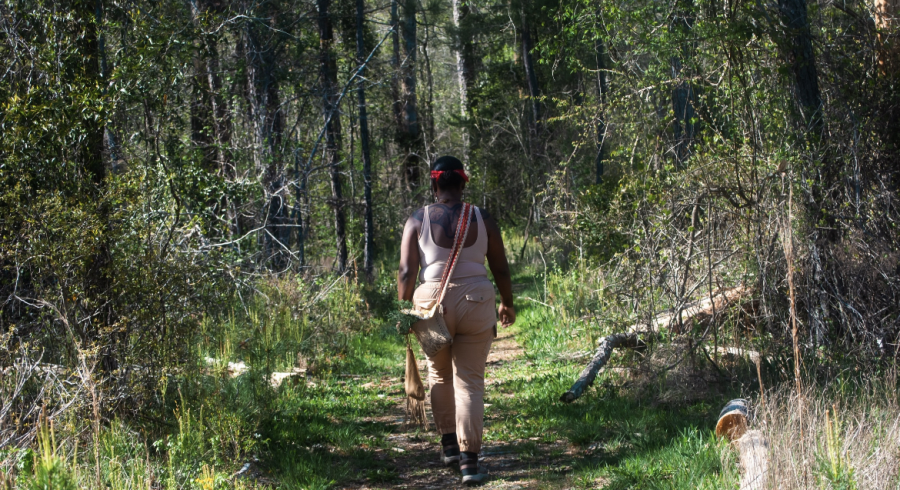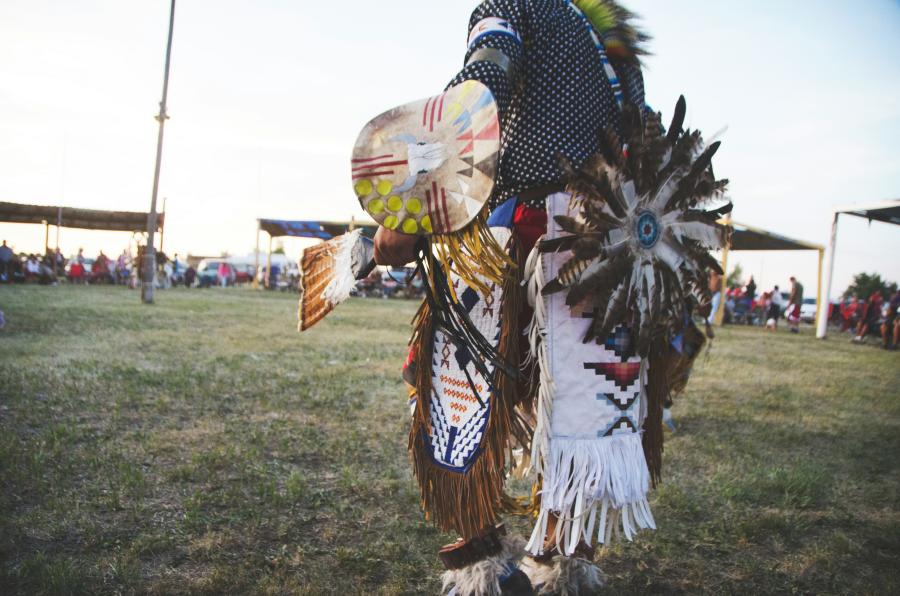Tourism is big business in the American Southwest. In the state of New Mexico, for example, the travel industry is now a billion-dollar enterprise and the number one employer. Native culture is one of the drawing cards for that industry; many tourists feel that seeing and interacting with "real Indians" adds an important dimension to their travel experience. This curiosity about Southwest native culture has caused numerous problems; nevertheless, many of the area's Indians - most of whom depend on tourist dollars for at least a portion of their family income - are responding to the challenge creatively and assertively.
"Adventure Tourism" and Its Limits
Tourism in the Southwest is still primarily characterized by small groups of tourists traveling in automobiles. Travelers who arrive by air typically rent cars if they wish to visit Indian reservations and prehistoric ruins. Several "adventure tourism" outfits have recently begun to offer group trips that feature interactions with individual Indians along with a glimpse at traditional native life.
One such organization, the National Audubon Society Expedition Institute, offers a summer expedition to the Southwest; its catalog promises "Hopi, Navajo and Zuni Indians [telling] their human history" and "Hopi dances expressing harmony with the Earth." Another organization, the Southwest Wilderness Center, features Rio Grande rafting trips with a Tewa Indian guide who will "tell you about his culture, history, and mythology." This rafting trip ends with a visit to Santa Clara Pueblo, where "we will be served Indian tacos as we watch the early evening light play on the cliffs of Black Mesa."
Adventure tourism capitalizes on and therefore fosters the tourist's desire to meet native peoples, promoting the idea that museums or cultural centers are no substitutes for actual human contact. Naturally, this emphasis on personal interaction puts considerable pressure on native peoples. They must protect their homes, villages, and activities from becoming tourist attractions, and they must develop ways to control the flow of visitors and place limits on how far "backstage" those visitors may roam. The Pueblo people of New Mexico and Arizona appear to be actively setting such limits.
The entrance to a Pueblo Indian reservation is marked by one or more signs listing the village's regulations for visitors. Typically these signs prohibit photography, sketching, and notetaking, and some set a village curfew for visitors. Sometimes portions of a village are marked as being off-limits to visitors, and an entire village might be temporarily closed during certain ritual occasions, a limitation that might even be enforced by armed guards at the village entrance.
The Pueblo village officials are very serious about their rules and vehemently enforce them. Violators might be fined, have their film confiscated, or be escorted out of the village. When visitors set foot onto a Pueblo reservation, they must accept a new set of rights and obligations.
The assertive stance of Pueblo Indians toward tourism is most evident during the open village ritual dances. Tribal police and village war captains watch tourists closely during these events, working hard to prevent them from getting too close to the dancers, the sacred shrines, and the kivas (sacred ceremonial chambers, which are closed to non-Indians except in the villages of Hopi and Zuni). The ritual clowns will make fools of any tourists who do not act "with respect" or who are simply "in need of some humility."
Tourists seeking an authentic cultural experience often accept and even applaud the Pueblo regulations. Many of them probably feel that following the rules is a small price to pay for "authenticity" and might even see those rules as evidence that the Pueblo people have not "sold out." A tourist who is made "the fool" by a clown might suffer embarrassment at the moment, but the experience allows him or her to participate in the event and provides great material for a story later on.
Traditional Tourism
The desire for contact with native people is also evident among the less adventurous tourists, those who would rather stay in the cities. In New Mexico one of the few places where these tourists can interact with Indians is in Santa Fe, under the portal of the State Museum's Palace of the Governors.
As tourists stroll along the portal of the Palace of the Governors, they see a row of about 50 Indian vendors, each sitting behind a cloth spread on the ground displaying wares for sale. The scene is quaint and colorful and attracts hundreds of visitors every day. What most tourists do not know, however, is that this scene is carefully constructed and regulated and that the vendors work with a long list of regulations established by the Museum of New Mexico.
The first rule of selling under the portal is that vendors must be American Indians who can prove membership in a New Mexico pueblo or tribe. The second rule is that the goods sold there must be handmade by the seller. To enforce these rules, the museum had to establish an elaborate set of procedures and additional, supporting regulations.
These procedures and regulations are updated each year in a process that begins in April, when the museum holds a meeting for all participants in the portal program. During this meeting, proposed revisions to the guidelines are presented, discussed, and voted upon. In addition, a Portal Committee is elected to represent the participating vendors. This committee has to monitor the program daily, appointing one or more "duty officers" who inspect goods to determine their authenticity as Indian handmade crafts. The committee works directly with the director of the Palace of the Governors (a non-Indian, to date), who chairs the annual meeting and has the power to waive certain requirements in special cases.
The more detailed regulations currently enforced by the committee and the director include the assignment of spaces by lottery; a restriction on the use of tables or elevated stands for display; a limit of one space per household; a prohibition on making for-sale items in the designated selling area; a restriction on children accompanying the vendor; a limit of one assistant per vendor; a restriction on social activities that might disrupt sales; a rule that goods left unattended must be covered with a cloth and cannot be left for more than one hour (or the space will be re-assigned by the duty officers); and the stipulation that all goods offered for sale must be marked with the maker's "seal." There are also rules concerning the materials and processes used in the manufacture of goods; pottery, for example, must be made from clay found on the vendor's reservation and must be constructed without the use of a potter's wheel.
The museum's position on Indian arts and crafts can be traced back to Edgar Hewett, anthropologist and the museum's founding director (the museum was founded in 1909). Hewett felt that the younger generation of native peoples did not value the arts of their cultural heritage. He became committed to encouraging "excellence" in Indian arts through competitions, education programs, and selective patronage. Hewett set forth a program of conscious revival and encouraged individual Indian artists to produce work conforming to his personal definitions of "quality" and "tradition." It is noteworthy that Hewett's views were directly and indirectly communicated to early tourists through his public lectures on Indian arts and his training lectures for many of the famous Fred Harvey Company tour guides, as well as through the museum exhibits and the selection of award-winning works during the annual Santa Fe Fiesta and the later, annual Indian Market.
In 1979 the museum's "Indian-only" policy was challenged in the courts by Paul and Sara Livingston, non-Indian vendors who claimed the museum was guilty of a reverse racial discrimination which violated their constitutional rights under the Fourteenth Amendment. The Livingstons lost both the case and, later, the appeal. Judge William E. Doyle, United States Court of Appeals, Tenth Circuit, concluded that the museum's policy did not reflect racial discrimination but rather justifiable cultural discrimination. Doyle supported the earlier opinion of the trial court that "only Indians can make Indian goods" and that "it is permissible under the Constitution to promote a unique culture effort such as the French Quarter in New Orleans and this Indian Market in Santa Fe" (Livingston v. Ewing, 601 F.2d 1979:1,112). Doyle specifically stated that the practice of Indians selling under the portal was important to tourism: "The Indians... render a valuable service to the Museum by bringing tourists to the Square... the public buildings and to the private shops" (Livingston v. Ewing, 601 F.2d 1979:1,114). Indians selling under the portal, he said, "is one element of a comprehensive program to allow the general public to meet the Indians and to gain information as to the character and quality of the Indians' work" (Livingston v. Ewing, 601 F.2d 1797:1,116).
At first the Indian vendors were delighted to have non-Indians barred from their selling space. As the regulations grew more elaborate, however, some were not so pleased - a sentiment that continues to this day. Many vendors resent that the Santo Domingo Pueblo Indians, who outnumber any other group, have control over the operation simply because they are in the majority. Others resent the idea that they can only sell what they make since some families only make one type of jewelry and had previously traded in order to acquire other types of jewelry to sell. Still others complain that there is no room for innovation in their crafts.
Questions concerning the Indian-only policy recently resurfaced in the New Mexico newspapers when the city of Albuquerque took steps to follow Santa Fe's example. At the time of this writing, the Albuquerque City Council is considering a bill preventing non-Indians from selling in front of the La Placita Restaurant in the historic Old Town District. If approved, this ordinance would also limit the goods that could be sold, permitting only those handmade by Indian vendors. As in Santa Fe's case, the arguments for this ordinance include the protection of opportunities for tourists to come in direct contact with native people.
The Tourism Challenge
As more and more tourists search for contact with "real natives," and as the tourist industry continues to nourish these wishes, native peoples will have to be forthright about the nature of these encounters. If they do not meet this challenge, they will be reduced to nothing more than passive tourist attractions. Because tourism has come relatively slowly to the Southwest - steadily increasing since the turn of the century - and because native peoples in the Southwest have considerable control over their reservations, they might find the balance between maintaining their cultural autonomy and benefiting from tourism economically and socially. The fact that people travel long distances to see them presents problems of intrusion but also provides them with a market for their arts and sends a positive message to Indian people about the strength and beauty of their cultural ways. Achieving this balance could be further complicated by well-intentioned "experts," such as Hewett and other anthropologists, who have knowingly or unintentionally influenced native people's responses to the demands of tourism. Finding positive ways to cope with tourists' desire for contact will be one more critical challenge for Southwest Indians in their long and difficult struggle for survival within the contemporary, Anglo-dominated American society.
References
Evans-Pritchard, D.
1987 The Portal Case: Authenticity, Tourism, Traditions, and the Law. Journal of American Folklore 100:287-296.
Sweet, J.D.
1989 Burlesquing "The Other" in Pueblo Performance. Annals of Tourism Research 16:62-75.
American Indian Societies
Strategies and Conditions of Political and Cultural Survival
Duane Champagne
Many cultures throughout the world now confront issues similar to those encountered by American Indians over the past 400 years. By examining the various American Indian societies, Duane Champagne presents an historical and comparative method for explaining the empirical range of change within a society's methods for ensuring political and cultural survival. This comprehensive history of the structure and change among American Indian societies should be of interest to anyone seeking to identify the specific conditions necessary for indigenous societies to retain their autonomy.
Cultural Survival Report 32
Paperback 6"x9". 184 pages. $10 paperback; $19.95 hardcover (please add $2 for postage and handling).
Order from
Cultural Survival Publications
11 Divinity Ave., Cambridge, MA 02138
Article copyright Cultural Survival, Inc.



